ON Friday, November 25 members of Thorverton History Society had the great pleasure of a talk "Our Thorverton church: Fabric and Folk" on our own local parish church, St Thomas of Canterbury, given by two of our very own members, Jean Brown and Ian Stoyle, and to a full house!
Jean led off with an observant and well researched talk on the fabric of this lovely listed building drawing on archival documents and her own observations.
In common with many parish churches in Devon the church reflects the wealth of the Devon cloth industry but also has its roots in a far earlier foundation, indeed the board of rectors inside the church goes back to 1216.
The Diocesan records office has documents showing that Henry II who reigned from 1154 to 1189 granted the Manor and church to St Martin’s Marmoutier in France and any structure of that time would have been a vastly simpler, single storey church as evidenced by the tantalising architectural clues on the exterior East wall.
There is little other evidence remaining of this first church apart from possibly the font and the curiously carved stone at the base of the porch staircase.
Jean took us through some of the later medieval features within the church such as the lovely angels topping the pillars and the remnants of Tudor roses and pomegranates dating back to the wedding of Catherine of Aragon to Henry XVIII in 1509.
Although the seating was added to in 1840, the pew ends in the Lady Chapel are the remnants of medieval carvings which were retrieved from Powderham Castle in 1864, and where some still remain to this day.
The Lady Chapel altar and screens were installed from the remains of St Edmund’s Chapel on the Exe bridge as recently as 1971.
The porch is another area of carving and figures often missed while the structure and layout of the church has been changed over the ages to remove a screen and rood loft as well as to raise the roof from three roofs with gulleys to the present day single span roof.
The tower clock dates back to 1745 although the dial belongs to the 1900s. Many Victorian improvements feature in our present church including the organ, memorials and the altar furniture as well as the lovely stained glass windows that we have so recently been lucky enough to have reset, repaired and cleaned.
Many of the features were followed up by Ian in his talk on the "Folk" of St Thomas evidenced in the memorials and tombs of the churchyard and building as well as describing the personal impact of the many significant people on the Thorverton community.
The oldest monument, near the altar, belongs to the Tuckfield family who were lords of East Raddon in the 1600s as well as the later Pugh family who were the richest of their time in the late 18th century.
Many of the windows, monuments and information centred on the Coleridge family such as Luke Herman Coleridge who died in Thorverton (a brother to the famous poet) and commemorated by his son, the then Bishop of Barbados.
Later the Rev James Duke Coleridge became a significant catalyst for change in the village during his tenure as vicar (1839-1857). Looking up at the corona of lights you will see these bear their names as well as that of Samuel Childs Clarke, another later and apparently equally unpopular conservative rector!
The Moxey and Edwin Harry Coombe windows are equally splendid windows providing clues to persons of significance in their time as well as the rolls of honour for the great wars.
There is so much to appreciate within the church and many contemporary changes still taking place where we have the wonderful working bells as well as many and innovative functional uses for its wonderful space.
This was a detailed and interesting talk to a very appreciative audience.
Our next meeting in January will allow members to deliver small talks on their own interests as well as dealing with the business of the Society’s administration and in February we look forward to a talk on the Exe Valley Railway …another feature of well remembered history.
K A Marshall




